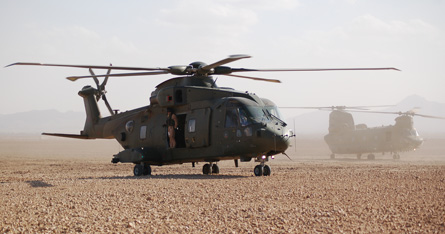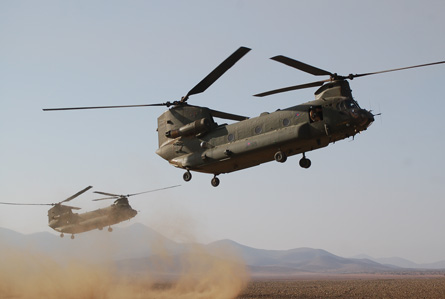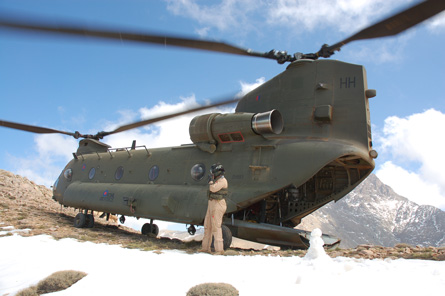Today's military air arms are faced with a major challenge: to meet the maxim to "train like you fight" while overcoming severe restrictions in equipment, personnel or budget, and sustaining often long-running commitments to combat or peacekeeping operations.
With at least six different aircraft types currently supporting coalition campaigns in Afghanistan and Iraq, the UK's tri-service Joint Helicopter Command (JHC) provides an ideal example of an organisation that is attempting to maintain this delicate balance between preparing crews for the enduring demands of current operations, but also training for the unknown requirements of the future.
Flightglobal.com visited a recent major exercise involving two of the Royal Air Force's principal transport helicopter types. Staged from a base at Ram Ram near the Moroccan city of Marrakesh, Exercise Jebel Sahara sought to broaden a training regime that one senior commander says has seen the air force "myopically fixate on the Arabian deserts" over recent years.
Conducted from 6-28 October, the exercise involved three of the RAF's Boeing CH-47D Chinook HC2/2As and two of its AgustaWestland AW101 Merlin HC3s. Reflecting the busy nature of both forces over recent years, the manoeuvres represented the first time that the types had trained together since 2005.
 |
|---|
All images © Craig Hoyle/Flightglobal.com |
The Joint Helicopter Force (Morocco) (JHF(M)) detachment also involved almost 160 personnel, including 12 air crews from the Chinook force's 18 and 27 squadrons and 10 crews from the Merlin community.
A quarter of the RAF's 40-strong Chinook inventory is now assigned to operations in the Gulf region, with nine aircraft in Afghanistan and one in Iraq. Aircraft from its 22-strong Merlin HC3-equipped 28 Sqn have meanwhile logged more than 15,000 flight hours in Iraq, with operations continuing from the southern Iraqi city of Basra.
"We used to do dissimilar training, but the tempo of operations had forced us to not work together," says Wg Cdr David Morris, Merlin detachment commander for the recent exercise. Crews from both types use the CAE Aircrew Training Services-managed Medium Support Helicopter Aircrew Training Facility at the Merlin force's home base at Benson, Oxfordshire, but typically focus on their separate mission requirements.
VIDEO: Merlin
The UK armed forces have struggled to conduct adequate "all-arms" training activities since early in this decade, with overseas exercises posing a financial burden on a defence budget already hard-strained by operations in Afghanistan and Iraq. But senior officials are now pushing for larger scale and more regular periods of training, which they argue will deliver a better standard of personnel more able to adapt to new situations.
"We have self-deployed the aircraft to an austere site with conventional support and are training in an unfamiliar environment by day and night, and flying up to 10,000ft [3,050m] with snow and sand in the same sortie," says Chinook force commander Gp Capt Andy Turner. "That stretches our aircrews, and makes them think differently."
 |
|---|
The JHC used the recent manoeuvres largely for environmental training purposes, but other activities included troop transport, formation flying, gun firing using M60 and M134 weapons, and combat survival training. A standards team also visited the exercise to ensure that common practices are in use, including across aircraft types.
Further activities included testing a so-called "desert box" rolling landing technique (below) intended to overcome the dangerous effects of "brown-out" conditions. The activities included multi-ship operations with both aircraft types, which use significantly different landing approach techniques.
 |
|---|
Using opportunities such as the Jebel Sahara framework, a long-standing series of events primarily involving the Moroccan military and the British Army's Royal Gibraltar Regiment, the RAF plans to dramatically increase the number and variety of exercises for the Chinook and other types, says Turner.
Such activities are "contingent for rapid response" duties, and important in meeting a goal for "global readiness", Turner says. "I would like to shift conversion activities to here, and also use the transit to learn," he adds. This would meet an aspiration to get new crew members to limited combat ready status, reduce the amount of low flying conducted in the UK, and ensure that crews do not learn lessons for the first time under combat conditions, Turner says.
Jebel Sahara, meanwhile, provided a first opportunity for the Merlin force to deploy the aircraft's ISO container-housed support system, which comprises flight planning, rectification and welfare units for squadron personnel, including around 20 engineers. One of the two aircraft deployed by 28 Sqn also tested the type's enhanced health and usage diagnostic system.
Using one laptop computer per aircraft, this links maintenance information back to the UK to support supply chain planning activities. The Merlin is the UK's first support helicopter to use the EHUDS technology, and deputy engineering officer Chief Tech Darren Whammond notes: "It's a very good system, but it's early days."
Desert operations are particularly harsh on the Merlin (below), which must have its Rolls-Royce/Turbomeca RTM 322 engines inspected by boroscope after every 30 landings. An engine change can be performed in the field within 2-3h, if necessary. Both deployed aircraft had 120 flight hours available before their next periods of scheduled work at the start of the exercise, and were each expected to log around four flight hours a day.
 |
|---|
"You're at the extremes of release to service here," says Morris, who notes that as the Merlin's experience in Iraq has been gained largely at near sea level, "hot and high training is something we've really got to address". Conditions will be very different if the Merlin is committed to the NATO-led campaign in Afghanistan from 2009: the UK's Camp Bastion base sits at an altitude of around 4,000ft.
"For an electric aircraft the availability is remarkable," says Morris, while cautioning that the Merlin "was never designed to operate at 50°C [122°F] month on month." Although a firm decision has yet to be taken, defence secretary John Hutton in late November confirmed that the UK is "examining options to deploy Merlin helicopters and additional Chinook airframes to Afghanistan".
The RAF's Merlin HC3s have already received wide-ranging modifications under urgent operational requirement (UOR) deals linked to their use in Iraq. Work has included communications and defensive aids system upgrades, the integration of a pintle-mounted general-purpose machine gun, improved ballistic protection, an underslung load capability (below), a forward-looking infrared sensor upgrade and the addition of night vision display data.
 |
|---|
The aircraft will also in time be equipped with BERP IV main rotor blades, which are already in use on the six Merlin HC3As acquired from Royal Danish Air Force and now assigned to the RAF's 78 Sqn.
Such UOR modifications are overseen and embodied by the Joint Partnering and Relationships Team a combined effort involving AgustaWestland and the UK Ministry of Defence.
This has also provided improved communications and countermeasures equipment for the Chinook force, and a variety of modifications to the British Army's Westland/Boeing Apache AH1 attack and Lynx utility helicopters, RAF Westland Puma and Royal Navy Sea King transports, which are also supporting operations in Afghanistan and Iraq.
Current Chinook HC2/2As are also entering a wide-ranging upgrade effort to deliver a common aircraft configuration across the fleet. "Right now I'm 40 different aeroplanes, but you just get on with it," says Turner.
Key elements of the Project Julius effort, which initially involves eight aircraft, are the integration of digital avionics and an engine upgrade to Honeywell's T55-714 standard.
The work will later be expanded to cover all 48 Chinooks in the RAF's fleet, with operations of the type expected to continue until at least 2040 under the terms of Boeing's 34-year through-life customer support contract with the MoD, implemented in 2006.
Operations with the Chinook have increased by 25% since May in Afghanistan, and on average, one of the nine aircraft deployed to the country is rotated back to the UK every month.
Aircraft entering depth maintenance at Vector Aerospace Helicopter Services' Fleetlands site in Hampshire can have as much as 400kg (880lb) of sand removed from inside their fuselages on their return, highlighting the tough environmental conditions encountered by helicopters supporting the NATO-led fight against the Taliban.
 |
|---|
The RAF's overall use of its current 40 operational Chinooks is also on an upwards curve, with the fleet projected to deliver 16,000 flight hours this year. This is in part thanks to the UK Ministry of Defence's Boeing-led through-life customer support deal in place at Fleetlands, and a new support model at the type's main operating base at RAF Odiham, Hampshire.
The fleet will also be boosted from next year by the availability of eight stored Chinook HC3s, which are to undergo a so-called "reversion" programme led by Qinetiq.
"By improving crew arrangements and enhancing logistic support, we have increased available helicopter hours by around 60% in the last two years," says defence secretary John Hutton. "We will continue to investigate ways to get more capability out of our existing deployed airframes."
Turner believes more can be done to get extra from the versatile transport. "The US Army gets 200-250h out of a Chinook each year, and the RAF 400-450h, but Columbia Helicopters flies 1,400h with each of its [seven] Chinooks," he says. "We have a lot to learn from others."
VIDEO: Chinook
In addition to preparing crews for frontline operations, JHF(M) commander Wg Cdr Jock Brown says Jebel Sahara was "an ideal work-up for operations like the [2005] Pakistan earthquake", where RAF Chinooks were used to deliver disaster relief supplies.
The air force plans a further two similar exercises in Morocco in 2009, plus Arctic training in Norway in January and February. Along with planned amphibious training to potentially take place in the Mediterranean region next year, Turner says the increase in overseas training activities "will build a broader experience base and give more balanced crews". Sending the Chinook force's entire contingent of 120-130 pilots through each of the various training environments would take between two and three years to achieve, he adds.
 |
|---|
Separately, the JHC is expected to soon increase the frequency of its contribution to British Army-run "Grand Prix"-series exercises in Kenya from around twice a year to up to nine times a year, according to military sources.
"We are sustainably set in Afghanistan," says Turner. "But we must look at where we will be in 15 years and put it in train now."
For more Chinook news and images, see Flight's aircraft profile
Source: Flight International



















